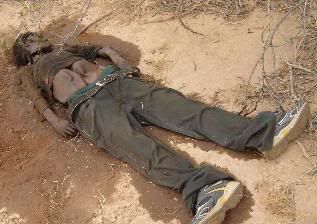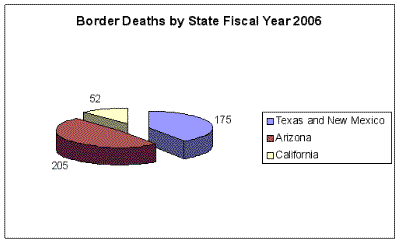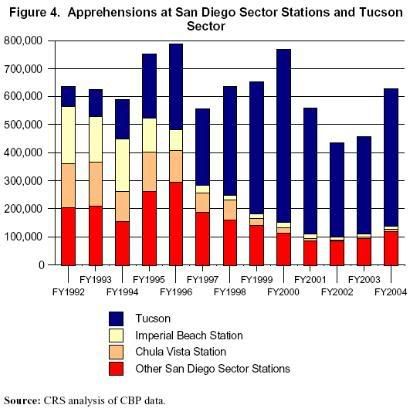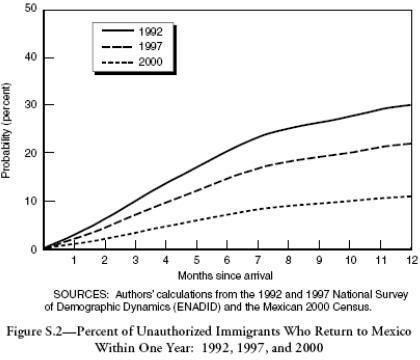Deceased Unauthorized Border CrossersProcessed & Identified by the Pima County Medical Examiner's Office, 1990-2005
(A “Doe” designation following a name means that the decedent was initially unidentified)
1990Date Found Name Age
5/1/1990 Martinez, Carlos 52
5/7/1990 Carrillo, Miguel Angel/ Doe #20 29
6/71990 Guerrero-Chavez, Juan/ Doe #31 30
7/7/1990 Cardena, Luis Gonzalez 40
7/21/1990 Ortiz, Ruben Corona UNKNOWN
10/18/1990 Coronel-Zazueta, Jose 26
1991Date Found Name Age
7/15/1991 Hernandez-Morales/ Doe #43 52
8/16/1991 Martinez, Juan C. UNKNOWN
1992Date Found Name Age
7/2/1992 De Leon, Faustino N. Gomez 17
11/14/1992 Zavala, Raul Reyes 29
1993Date Found Name Age
1/12/1993 Lopez-Ibarra, Juan Andres 33
6/18/1993 Ayala-Ventura, Juana Elena 25
8/2/1993 Hernandez, Odilon Lopez/ Doe #34 22
8/5/1993 Perez, Adan Rublero 31
10/14/1993 Cardoza-Lopez, Jesus Antonio UNKNOWN
11/19/1993 Rodriguez-Ramirez, Jesus Eberto 18
11/26/1993 Salcido, Gilberto Urquijo 19
12/2/1993 Rodriguez, Antonio Infante 23
1994Date Found Name Age
7/26/1994 Martinez-Garcia, Alfonso 44
1995Date Found Name Age
1/17/1995 Alvarez-Guadarrama, Rodolfo 48
3/9/1995 Lugo-Castro, Luis Enrique 24
5/20/1995 Martinez-Ibarra, Alejandro 27
11/4/1995 Alvarez-Salcedo, Rafaeal 38
12/21/1995 Cortez, Carmen Aguilar 45
1996Date Found Name Age
2/9/1996 Padilla-Ortiz, Jose Humberto 59
6/15/1996 Olivas-Cebreros,Gonzalo 34
6/15/1996 Olivas-Cebreros, Arcenio 29
6/15/1996 Soto-Munoz, Antonio 20
6/16/1996 Guicho-Almeida, Sergio 31
6/16/1996 Mazoraqui-Lopez, Jose 32
6/21/1996 RAMIREZ-TAPIA, DAVID 27
6/25/1996 Cardenas-Salazar, Jesus 35
7/3/1996 Montero-Torres, Enrique 19
10/18/1996 Acosta-Franco, Jorge Arturo 27
1997Date Found Name Age
3/4/1997 Celso Mendoza Rodriguez 32
3/19/1997 Melvin Osorio 21
3/20/1997 Isaias Marcilino Ordones-Vasquez 24
3/24/1997 Juan Jose UNKNOWN
3/27/1997 Pedro Sandoval Estrada 32
7/1/1997 Roberto Urbano Torres 54
7/11/1997 Jose Nava UNKNOWN
8/17/1997 Paola N Salazar 12
8/17/1997 Antonia C Garcia 35
8/17/1997 Nadia Ahumada 12
8/17/1997 Everardo G Ahumada 10
8/17/1997 Marcela G. Mendez 23
9/21/1997 Jose Luis Cano-Velasquez 36
9/21/1997 Juan Robles-Palencia 25
9/21/1997 Teresa Arreola Raya 28
12/14/1997 Oscar Pena Moreno 32
1998Date Found Name Age
5/3/1998 Joel Orlando Ibarra Lugo 21
6/28/1998 Rosa Cardenas 23
7/13/1998 Juvenal Silva-Ramirez UNKNOWN
7/14/1998 Rene Hernandez 18
7/25/1998 Sonja Soto-Escalante 17
7/28/1998 Ana Claudia Villa Herrera 17
7/29/1998 Miguel Angel Vasquez Godinez 23
8/20/1998 Elidia Martinez-Macario 27
8/23/1998 Rolando Morales Solano 28
9/2/1998 Arturo Acosta Soto 27
9/9/1998 Antonio Renteria Martinez 26
9/20/1998 Jose Martin Molina Panuco 23
1999Date Found Name Age
2/14/1999 Telesforo 42
4/4/1999 Hector Lopez Carrizoza 30
4/5/1999 Cesar Ramos Fernandez 44
5/15/1999 Martin Ortega-Campos 33
6/15/1999 Ramon J Gonzalez Salazar 51
6/17/1999 Cuahtemoc Lavin Valentin 45
6/17/1999 Hector Lavin Martinez 25
6/24/1999 Jose Guadalupe Llaninto-Villalobobs 35
7/4/1999 Aaron Moises Delgado Lopez 18
7/7/1999 Alejandro Felix Barraza 19
7/21/1999 Roberto Ramirez-Ramirez 47
7/24/1999 Manuel Artalejo 19
8/1/1999 Carmen Margarita Martinez 19
9/19/1999 Veronica Nadia Lopez Munoz 21
10/26/1999 Olivio Claudio Velazquez-Perez 53
11/11/1999 Modesto Santos-Flores 20
11/23/1999 David Maldonado Quijada 29
 2000
2000Date Found Name Age
1/22/2000 Tomas Mateo Nicolas 17
2/5/2000 Maria Del Rocio Candia-Bravo UNKNOWN
2/5/2000 Natali Enriquez-Hipolito UNKNOWN
2/5/2000 Luis Roberto Morales Avenado UNKNOWN
2/5/2000 Emma Montecarlo Castillo 40
2/14/2000 Isidro Digno Gamez 40
2/29/2000 Delia Moreno Perez 24
3/6/2000 Vicente Gonzalez-Ramirez 46
3/6/2000 Alfredo Uvieta Dominguez 34
3/7/2000 Jose Ines Diaz Gonzalez 18
3/20/2000 Gerardo Nevarez Gallegos 26
3/23/2000 Jose Luis Rojas Inigo 30
3/30/2000 Carlos Miguel Gonzalez Corona 17
4/5/2000 Angel Selvas Ruiz 34
4/14/2000 Zenon Resendiz Nieto 27
4/16/2000 Herlindo Martinez-De Jesus 28
4/27/2000 Eusebio Garcia-Perez 33
5/9/2000 Marina Montano Mercado 26
5/18/2000 Jose Angel Adrian Mendoza Mendoza 40
5/21/2000 Hector Guadalupe Sanchez-Murrieta 22
5/23/2000 Fermin Aguilar Rabadan 34
5/29/2000 Yolanda Gonzalez Galindo 19
5/30/2000 Maria Cruz-Ruiz 45
5/30/2000 Maura Zacarias Sanchez 31
5/31/2000 Juana Medina Butanda 41
5/31/2000 Juan Manuel Acosta Rojas 28
6/1/2000 Enrique Soto Pacheco 19
6/3/2000 Oscar Cervantes-Melquiadez 19
6/3/2000 Froylan Flores-Hernandez 32
6/3/2000 Hugo Sanchez Acevedo 18
6/5/2000 Jose Guadalupe Rico-Sanchez 35
6/5/2000 Guillermina Herrera Guzman 26
6/6/2000 Mainor Gerardo 23
6/7/2000 Enedina Torralba-Martinez 26
6/14/2000 Mario Calderon Jimenez 10
6/14/2000 Eutiquio Dorentes Marin 45
6/15/2000 Laura Vargas Ortiz 22
6/19/2000 Pedro Basulto Neri 20
6/26/2000 Jose Manuel Leos 36
6/28/2000 Antonia Mendez Mendez 16
7/7/2000 Modesta Perez-Pacheco 45
7/24/2000 Victor Manuel Blas-Vargas 29
7/24/2000 Mauro Garcia Martinez 31
7/27/2000 Raul Lopez-Sachez 25
8/9/2000 Demetrio Velez Garcia 25
8/15/2000 Amador Cazares-Sanchez 22
8/23/2000 Miguel Angel Chiguil-Arres. 14
8/29/2000 Rigoberto Alvarado Garcia 24
8/29/2000 Omar Alfredo Cerna-Giraldo 20
8/29/2000 Herlinda Infantes-Mejia 28
9/3/2000 Paula Isela Romero-Palacios 23
9/5/2000 Isaura Bibiana Medina Paredes 25
9/12/2000 Fortino Herrera-Gervasio 24
9/12/2000 Juventino Merida-Fuentes 52
9/21/2000 Norma Leticia Herrera-Navarro 21
9/29/2000 Olivia Vallarta-Coronado 32
10/28/2000 Angel Ledesma-Raya 43
10/31/2000 Jose Luis Lopez-Martinez UNKNOWN
11/12/2000 Juan Pinacho-Rodriguez 26
2001Date Found Name Age
5/9/2001 Fernando Cruz-Mendoza-Cruz 31
5/17/2001 Alicia Adela Sotelo-Mendoza 46
5/23/2001 Felipe Sanchez-Najera 53
5/24/2001 Lorenzo Hernandez-Ortiz 34
5/24/2001 Raymundo Barreda-Landa 15
5/24/2001 Reyno Bartolo-Fernandez 37
5/24/2001 Mario Castillo-Fernandez 25
5/24/2001 Enrique Landeros-Garcia 30
5/24/2001 Raymundo Barreda-Maruri 54
5/24/2001 Julian Ambros-Malaga 24
5/24/2001 Alejandro Marin-Claudio 28
5/24/2001 Arnulfo Flores-Badillo 42
5/24/2001 Edgar Adrian Martinez-Colorado 23
5/24/2001 Sergio Ruiz-Marin 23
5/24/2001 Efrain Gonzalez-Manzano 24
5/24/2001 Heriberto Badillo-Tapia 18
6/1/2001 Daniel Beltran-Rojas 24
6/1/2001 Armando Rosales-Pacheco 25
6/3/2001 Buenaventura Ayala-Zamora 45
6/8/2001 Roberto Bautista Lopez 19
6/11/2001 Anastacio Lopez-Guerrero 38
6/16/2001 Martin Espinoza-Cruz 40
6/18/2001 Adela Salas-Perez 30
6/19/2001 Guadalupe Octaviano-Nieto 21
6/20/2001 Enrique Mendoza-Castillo 42
6/22/2001 Rosario Sanchez-Rogel 45
6/25/2001 Lauro Barrio-Dominguez 23
6/26/2001 Jose Romero-Luna 43
6/30/2001 Maria Dolores Espinoza-Morales 31
7/2/2001 Alvaro Segovia-Garcia 22
7/2/2001 Julio Cesar Garcia-Soto 23
7/2/2001 Francisco Carreles-Camacho 26
7/2/2001 Alejandro Gutierrez-Hernandez 46
7/7/2001 Alberto Maldonado-Viveros 30
7/11/2001 Esteban Duran-Aburto 31
7/12/2001 Carlos Armando Bustamonte-Garcian 22
7/13/2001 Jorge Alonso Mirelles 24
7/14/2001 Juana Martinez-Miranda 26
7/15/2001 Andrea Alcantar-Cruz 24
7/20/2001 Abel Gonzalez-Dominguez 34
7/24/2001 Hermila Romero-Carreon 29
7/30/2001 Lugarda Iracema Martinez-Jiminez 19
8/1/2001 Petra Veronica Tenorio-Soto 30
8/7/2001 Santiago Pacheco-Ramirez 43
8/22/2001 Dalvin Eugenio Urbina-Kirk 21
8/29/2001 Didier Villanueva-Garcia 27
9/2/2001 Catalina Ventura-Mendoza 43
9/2/2001 Irene Gutierrez-Hernandez 35
9/4/2001 Lizbeth Juarez Riofrio 23
9/11/2001 Mateo Gaspar-Vargas 43
9/21/2001 Lydia Dimas-Tellez 27
9/25/2001 Graciela Alvarado-Hernandez 28
11/5/2001 Heriberto Nunez-Robles 25
11/25/2001 Casimaro Torres 38
11/28/2001 Ernesto A Gutierrez-Ramirez 16
11/28/2001 Jose Garcia 24
2002Date Found Name Age
1/6/2002 Cesar Leobardo Arguellas-Herrera 30
1/8/2002 Maria Luisa Leticia Lozano-De La Rosa 32
1/27/2002 Tomas Molina-Perez 35
2/18/2002 Martin Martinez-Grijalva 38
2/19/2002 Carlos Garcia-Aguirre 25
2/20/2002 Castulo Salazar-Ontiveros 54
2/24/2002 Domitila Mondragon Alvarado 38
3/11/2002 Miguel Fructuoso-Hernandez 44
3/15/2002 Miguel Ochoa-Gonzalez 39
3/22/2002 Arturo Heras-Espinoza 34
4/7/2002 Jesus Rojas-Villas 35
4/12/2002 Alfonso Hernandez-Hernandez 23
4/12/2002 Victor Diaz-Acevedo 29
4/12/2002 Claudio Martinez-Cortez 34
4/18/2002 Martin Moreno-Montero 45
5/7/2002 Juana Gonzalez 26
5/7/2002 Alonso Caloca-Vargas 27
5/19/2002 Jose Lara-Avila 19
5/22/2002 Simeon Diaz De La Cruz 41
5/28/2002 Rene Resendiz-Rodriguez 26
5/30/2002 Salvador De La Paz Macedo 21
5/31/2002 Francisco Javier Trujillo-Ruiz 18
5/31/2002 Rene Rodriguez-Ramirez 22
6/6/2002 Raul De Anda-Lopez 54
6/6/2002 Norma Rodriguez-Amaro 22
6/7/2002 Margarita Rio-Rodriguez 30
6/7/2002 Jaime Rodriguez Gutierrez 25
6/7/2002 Sofia Rubio-Chavez 19
6/7/2002 Antonio Vargas-Torres 24
6/8/2002 Santiago Arcos-Mota 28
6/8/2002 Jose Manuel Raygoza Gil 14
6/8/2002 Maria Guillermina Sanchez-Salto 30
6/8/2002 Alex Sosa-Coba 24
6/8/2002 Paula Hernandez-Tapia 31
6/8/2002 Rogelio Cruz-Cervantes 52
6/9/2002 Arturo Luciano Gomez-Castro 27
6/9/2002 Ricardo Pantaleon-Santiago 18
6/9/2002 Victor Galindo Torres 21
6/10/2002 Luis Fernando Us Tun 18
6/13/2002 Margarito Escoricia-Franco 26
6/14/2002 Arturo Ruiz-Gutierrez 23
6/14/2002 Maria Elena Lopez-Gomez 17
6/16/2002 Adilene Lopez-Moreno 11
6/17/2002 Rafaeal Lopez-Mendez 19
6/18/2002 Santos Fabian Gonzalez-Paredes 21
6/19/2002 Eva Hernandez-Escarcega 31
6/19/2002 Angeles Contreras-Gonzalez 22
6/23/2002 Carlos Valdez-Gortari 46
6/22/2002 Jose Luis Hernandez-Aguirre 25
6/23/2002 Jose Mendez-Gomez 26
6/23/2002 Saul Segura Oliveros 21
6/24/2002 Domingo Lopez-Lopez 20
6/26/2002 Gonzalo Gonzalez-Saldana 34
6/28/2002 Blanca Estela Garcia-Reyes 36
6/29/2002 Ramiro Garcia-Abarca 18
6/29/2002 Mauro Santos-Tolentino 55
7/3/2002 Jose Salazar-Velarde 46
7/3/2002 Blanca Reyna Salinas-Espinoza 23
7/5/2002 Ruben Gonzalez-Miranda 49
7/5/2002 Jesus Torres Santiago 20
7/5/2002 Alejandro Hernandez-Badillo 16
7/9/2002 Cristina Dominguez-Librado 35
7/9/2002 Maximo Barrera-Esquivel 35
7/11/2002 Leonel Tuxpan-Grano 33
7/12/2002 Francisco Javier Roman Olivan 18
7/12/2002 Raul Estrada-Frias 26
7/13/2002 Joel Aguila Hernandez 28
7/14/2002 Ismael Tepox-Gamboa 35
7/14/2002 Eledi Sanchez-Cirilo 41
7/18/2002 Maria Dolores Moreno-Trejo 10
7/18/2002 Dolores Trejo-Ramirez 53
7/21/2002 Alberico Cordova-Robledo 43
7/21/2002 Oscar Irineo-Santillan 18
7/21/2002 Maria De Jesus Ruiz Garcia 31
7/22/2002 Jesus Balandran-Hernandez 43
7/27/2002 Damaso Rosales-Zamudio 27
8/4/2002 Juan Manuel Dominguez Quintero 33
8/8/2002 Jorge Antonio Yin-Cervantes 28
8/8/2002 Jaime Artega-Alba 22
8/8/2002 Adalberto Lopez-Zuniga 37
8/9/2002 Panfilo Murillo Aguilar 28
8/10/2002 Mirabel Munoz-Bustos 22
8/10/2002 Claudia Patricia Oqunendo-Bedoya 40
8/10/2002 Elizabeth Hahuatzi Martinez 36
8/11/2002 Roberto Rodriguez-Rodriguez 14
8/11/2002 Francisco Tovar-Frausto 41
8/11/2002 Mari Carmen Serapio-Xaltenco 19
8/14/2002 Alejandrina De La Soledad Felix Sanchez 23
8/15/2002 Leandro Bautista Alba 58
8/15/2002 Enriqueta Martinez-Velasquez 46
8/16/2002 Jose Alonso Pulido 43
8/17/2002 Juana Santa Cruz Garcia 34
8/17/2002 Conrado Negrete-Venegas 39
8/26/2002 Eugenio Reyes-Gonzalez, Doe 94 48
8/27/2002 Alfredo Escobar-Lopez 37
8/28/2002 Alma Del Cruz-Lopez 25
8/31/2002 Jesus Humberto Ballesteros-Ortiz, Doe 98 17
8/31/2002 Pablo Hernandez-Espinoza 27
8/31/2002 Hipolito Hernandez Santiago 38
9/1/2002 Luis Bernardo Rodriguez-Tuyub 15
9/3/2002 Gilberto Menendez Gutierrez 33
9/4/2002 Alfaro Marquez-Campos 22
9/4/2002 Cecilio Cabrera-Pedro 37
9/5/2002 Maria De La Cruz Magana-Hernandez 20
9/5/2002 Maria Elena Morales-Sierra 45
9/5/2002 Jose Carlos Wicab-Chable 15
9/5/2002 Omar Sanchez Guevara 26
9/6/2002 Raquel Diaz Sarabia 34
9/9/2002 Jose Luis Rodriguez-Coronel 42
9/9/2002 Victor Manuel Talavera Figueroa 27
9/14/2002 Victor Hugo Davila-Ehuan 24
9/14/2002 Juan Rodriguez Sanchez 24
9/16/2002 Franklin Silva 30
9/16/2002 Jose Luis Vergara Flores 38
9/20/2002 Abel Martinez Faustino 17
10/11/2002 Carlos Garcia Bravo 18
10/16/2002 Jose Guadalupe Juarez Lopez 40
10/25/2002 Armando Saldivar-Flores 39
12/4/2002 Alejandro Lopez Lopez 48
12/25/2002 Rosa Mercedes Cano Dominguez 31
2003Date Found Name Age
1/4/2003 Oscar Borbon Mendoza 34
1/25/2003 Jose Antonio Perez Rubio 16
2/11/2003 Felipe Antonio Villafana-Rosario 33
2/11/2003 Ricardo Ibarra Tellez 43
2/11/2003 Elia Perez-Ramiez 38
2/11/2003 Reyna Mercedes Peguero Sanchez 30
2/11/2003 Amalia Ortiz-Licona 22
2/14/2003 Cesario Ruiz-Cortez 54
2/15/2003 Gonzalo Gomez-Gomez 42
4/3/2003 Celso Villa Mexico 18
4/13/2003 Antonio Mora Martinez 38
4/26/2003 Pedro Bautista Stillborn
4/22/2003 Juan Jeronimo Altamirano 33
4/25/2003 Mariano Duran-Saucedo 40
5/1/2003 Gabriel Torres-Alcala 47
5/3/2003 Octavio Lopez Felix 24
5/17/2003 Jose Lopez Cardenas 35
5/21/2003 Jose Andres Aguayo Contreras 30
5/22/2003 Jose Luis Rodriguez Tavarez 38
5/23/2003 Jose Refugio Del Angel Ferral 42
5/23/2003 Francisco Chavez-Mojica 40
5/24/2003 Fidel Velasquez Perez 17
5/24/2003 Josefina Martinez Sanchez 40
5/25/2003 Jose Avila 64
5/27/2003 Martin Gallegos Perez 28
5/27/2003 Guillermo Federico Sanchez-Lomeli 27
5/29/2003 Luis Miguel Villa Castillo 20
5/29/2003 Jose Ignacio Sanchez Chaparro 43
5/29/2003 Avelino Andres Cabrera Gonzales 43
5/29/2003 Teresa Velasquez 16
5/29/2003 Jose Alberto Lozano Martinez 31
5/29/2003 Genaro Rosales-Martinez 26
6/1/2003 Matias Juan Garcia Zavaleta 29
6/2/2003 Roberto Torres Ramirez 28
6/3/2003 Rene Olvera-Medina 60
6/8/2003 Mario Gonzalez-Hernandez 45
6/12/2003 Elizabeth Sanchez Acosta 25
6/14/2003 Maria Cristina Hernandez Perez 2
6/14/2003 Clemen Aguilar-Izaguirre 24
6/16/2003 Jorge Aburto-Zamorano 38
6/17/2003 Sergio Mejia Perez 26
6/18/2003 Natividad Carlota De Leon Maldonado 37
6/29/2003 Eliseo Vargas Luna 29
7/1/2003 Keila Madai Velazquez-Gonzalez 15
7/1/2003 Adrian Diaz Dionicio 35
7/2/2003 Isabel Lucrecia Paxtor Morales 22
7/3/2003 Nivercino Rodrigues Da Silva 39
7/3/2003 Antonio Alvarez Solorzano 50
7/4/2003 Pedro Xochicale Tlapalcoyoa 21
7/7/2003 Hermina Fuentes-Sanchez 29
7/8/2003 Maria Florinda Xum Chan 30
7/9/2003 Nora Huertas-Hernandez 19
7/10/2003 Antonio Sanchez Montoya 32
7/12/2003 Antonio Rolon Hernandez 27
7/13/2003 Ermeria Jeanette Martinez Matias 31
7/13/2003 Maria Guadalupe Cayetano Cornelio 19
7/14/2003 Carlos Rojas Morales 24
7/14/2003 Maria De Los Angeles Contreras-Rojas 18
7/15/2003 Maria Guadalupe Vasquez Saavedra 21
7/15/2003 Fortino Vasquez Garcia 41
7/17/2003 Sergio Benitez Hernandez 38
7/16/2003 Esteban Salvador Sanchez Rojas (Doe #73) 29
7/16/2003 Enrique Antonio Lopez Alcantar 18
7/19/2003 Esequiel Vargas Mora 33
7/20/2003 Mauricio Salas Guerra 38
7/21/2003 Agustin Hernandez-Jimenez 23
7/21/2003 Ofelia Maria Garcia Chavaloc 33
7/21/2003 Maria Josefa Tax Hernandez 37
7/21/2003 Amado De Jesus De Jesus 28
7/22/2003 Martin De Jesus Bernabe 19
7/25/2003 Miguel Rodriguez-Marentes 56
8/7/2003 Flora Maria Reyes-Cruz 16
8/9/2003 Alfredo Gundino-Ruiz 22
8/9/2003 Cruz Fabela Munoz 44
8/10/2003 Juan Reyes Luna (Doe #94) 42
8/10/2003 Jose Fernando Martinez-Fuentes 31
8/13/2003 Wilmer Germain Quintanilla 26
8/12/2003 Manuel De Jesus Sanchez 25
8/14/2003 Ilda Roblero Roblero 23
8/15/2003 Juan Antonio Nila Valdivia 20
8/17/2003 Jose Manuel Gomez Cruz 16
8/17/2003 Nicolas De Jesus Garcia Ventura (Doe #103) 55
8/18/2003 Jaime Monroy Gamino (Doe #104) 28
8/18/2003 Victor Manuel Placencia Basilio 27
8/20/2003 Lorenzo Lopez Diaz 21
8/26/2003 Lucio Hernandez-Hernandez 25
8/27/2003 Carlos Ramon Bejarno Cruz 24
8/27/2003 Efrain Castro Ramirez (Doe#109) 50
8/30/2003 Antonio Garcia Gomez 28
8/30/2003 Ruben Garcia Gamino 21
8/30/2003 Miguel Cruz-Laurel (Doe#113) 57
9/1/2003 Miguel Diaz-Garcia 25
9/2/2003 Miguel Ernesto Guardado Flores 19
9/2/2003 Raymundo De Jesus Rodriguez Tobar 33
9/2/2003 Transito Guzman Escobar 35
9/8/2003 Ana Cruz-Garcia 31
9/9/2003 Willian Oswaldo Valle Alfaro (Doe 121) 20
9/13/2003 Juan Carlos Rico Orihuela 19
9/15/2003 Rolando Arce Valenzuela 24
9/18/2003 Nahum Martinez Solano 24
9/20/2003 Rafael Martinez Ruiz 34
9/22/2003 Jorge Rolando Cano Yeh 27
9/23/2003 Rosa Maria Arriaga Castillo 22
10/18/2003 Edgar Miguel Pucek 23
10/21/2003 Hilda Hernandez Baltazar (Doe #35) 38
10/24/2003 Faustino Berneo Rayon 31
10/25/2003 Daniel Haro (Doe 138) 21
11/4/2003 Nicholas Padilla Reyes 20
11/4/2003 Agustin Rita-Santos 40
11/4/2003 Isidro Gutierrez Reyes (Doe #144) 36
11/4/2003 Jose Manuel Alcon Villa (Doe #145) 26
11/24/2003 Valentin Estrada Bejarano (Doe#150) 38
11/30/2003 Andres Campana-Gonzalez (Doe#152) 30
12/1/2003 Altagracia Marbella Tapia-Guillen 21
 2004
2004Date Found Name Age
1/16/2004 Jose Marco Antonio Zavala 27
2/10/2004 Adrian Garnica Altamirano 20
2/10/2004 Eleuterio Guzman Hernandez 43
2/17/2004 Sotero Gomez Viveros 25
2/21/2004 Maria Lucia Martinez-Nava 26
3/2/2004 Carlos Castro Llescas 36
3/2/2004 Rolando Perez Vazquez 37
3/17/2004 Juan Loenel Lizarraga-Vizcarra 27
3/19/2004 Leopoldo Vazquez Hernandez 19
3/20/2004 Jaime Gonzalez Pablo 17
3/21/2004 Gabriel Ortega Flores 27
3/20/2004 Antonio Tirado Rodriguez 43
3/24/2004 Diana Raquel Garcia Velasco 19
3/24/2004 Dagoberto Solis De Coss 36
3/24/2004 Margarito Aguillares Hernandez 26
3/25/2004 Maria Del Carmen Sabino Garcia (Doe #12) 30
3/25/2004 Raul Ramos Chavez 19
4/3/2004 Jesus Esquivel Santiago 26
4/3/2004 Rosario Munoz Berrelleza 36
4/3/2004 Reynael Cortinez Roblero 24
4/4/2004 Fortino Soto Armenta 28
4/4/2004 Rodrigo Miranda Rivera 35
4/9/2004 Norma Moreno Hernandez 30
4/12/2004 Francisco Javier Acosta Sandoval 37
4/20/2004 Tomas Soto Granados 43
4/20/2004 Reyes Campos Zalazar 42
4/20/2004 Carlos Molina Torres 33
4/28/2004 Fidelina Bravo De Marzan 42
5/1/2004 Mario Alberto Rodriguez Perez 25
5/3/2004 Jose Ruiz Bravo 40
5/4/2004 Alvaro Ramos De Castilla 21
5/9/2004 Maria Fabiola Paloma-Rios (Doe 15) 18
5/14/2004 Francisca Alicia Flores Guifarro 42
5/15/2004 Jose Juan Pacheco Salazar 25
5/19/2004 Carlos Caballero Gonzalez (Doe #61) 27
5/22/2004 Santos Martin Perez-Perez (Doe #59) 26
5/22/2004 Carmen Avila Vargas (Doe #17) 22
5/30/2004 Armando Mendoza 27
5/30/2004 Pascual Perez Funez (Doe #62) 38
6/2/2004 Jose Lorenzo Quintanilla 24
6/2/2004 Arnelio Serrano Portillo 39
6/2/2004 Jose Maria Aquino (Doe #65) 21
6/5/2004 Maria Cristina Salinas Gonzalez (Doe #19) 19
6/7/2004 Sofia Beltran Galicia (Doe 20) 21
6/8/2004 Carlos Alberto Argueta Lezma (Doe #71) 42
6/10/2004 Mario Soto Trejo (Doe #72) 30
6/10/2004 Emilio Leon Dominguez 24
6/11/2004 Marcelo Infante Pereyra (Doe #73) 28
6/12/2004 Jose Angel Miranda Escobar 22
6/13/2004 Julian Mayor Arbelaez (Doe #77) 20
6/13/2004 Olivo Martinez- De La Cruz 34
6/15/2004 Rosa Viviana Torres Corona (Doe #22) 26
6/16/2004 Emelia Perez Santiago 45
6/16/2004 Leopoldo Menedz Murrieta 20
6/17/2004 Leodan Vinicio Cabrera Sanchez (Doe #78) 20
6/17/2004 Manuel Luis Ramirez Herrera (Doe #67) 40
6/18/2004 Jaime Roberto Ortega Orellana (Doe #80) 26
6/18/2004 Angel Alberto Lizarraga Prado 26
6/18/2004 Isaac Melo Mejia (Doe #81) 26
6/18/2004 Adalberto Bello Encarnacion (Doe #82) 34
6/21/2004 Jovita Martinez Agudo (Doe #23) 42
6/24/2004 Raquel Hernandez-Cruz (Doe #24) 23
6/24/2004 Isaias Juan Galvez Perez (Doe #84) 28
6/29/2004 Jorge Armando Say-Pacay (Doe #86) 32
7/3/2004 Ismael Gomez Herrera (Doe #87) 22
7/3/2004 Maricruz Farias-Amador (Doe #25) 24
7/3/2004 Blanca Estela Ferreyra Vidal 34
7/7/2004 Paulina Morales-Exiquio (Doe #26) 20
7/7/2004 Nancy Navarrete Hernandez (Doe #27) 26
7/9/2004 Maria De La Luz Florez Martinez (Doe #28) 30
7/9/2004 Librado Tolentino-Velasco (Doe #89) 47
7/9/2004 Mario Alberto Diaz Ponce (Doe #88) 36
7/10/2004 Oscar Belerrabano Hidalgo 26
7/11/2004 Julio Cesar Romero-Espargo (Doe #90) 23
7/12/2004 Marcos De La Cruz Sandoval 18
7/12/2004 Luis Armando Cataldo-Escorza (Doe #92) 21
7/14/2004 Maria Raimunda Ribeiro Silva (Doe #30) 53
7/19/2004 Salvador Andres Gonzalez Leyva (Doe #96) 28
7/20/2004 Sergio Cabrera Hernandez 26
7/22/2004 Ofelia Vicente Ixmai (Doe #33) 28
7/23/2004 Omar Francisco Ortiz Camacho 18
7/26/2004 Jesus Hernandez-Lopez 23
7/26/2004 Aurelio Rios Venegas (Doe #100) 51
7/26/2004 Veronica Duenas Ramirez 33
7/29/2004 Pablo Gerardo Lazaro (Doe #102) 24
7/31/2004 Rosa Pena Ocampo (Doe #37) 38
8/3/2004 Francisco Javier Sanchez Aguilar 31
8/5/2004 Luis Cisneros Ventura (Doe #105) 63
8/7/2004 Albertano Herrera Liborio (Doe #106) 25
8/10/2004 Maria Carina Cortes Portillo 50
8/12/2004 Madilio Gutierrez-Perez 20
8/15/2004 Manuel Batalla Gonzalez (Doe #110) 35
8/20/2004 Gustavo Adolfo Gonzalez Cruz (Doe #112) 17
8/22/2004 Jesus Roman Garcia (Doe 114) 35
8/25/2004 Jose Cruz Adame Zavala (Doe #115) 38
8/29/2004 Aurora Cuamba Magallon 32
8/30/2004 Jose Alfredo Garcia Martinez 31
8/30/2004 Enrique Morales Flores 44
9/1/2004 Pedro Alejandro Valencia Pinedo (Doe #119) 24
9/2/2004 Telesforo Santos Arroyo 38
9/2/2004 Victor Manuel Coyoy Sum (Doe #120) 51
9/5/2004 Olaf Avila Gonzalez (Doe #123) 19
9/7/2004 Leonardo Plata-Escamilla 41
9/8/2004 Jose Trinidad Alcocer Martinez (Doe #124) 37
9/14/2004 Abel Salina Cortes 17
9/14/2004 Humberto Hernandez-Hernandez 35
9/14/2004 Jose Narciso Hernandez-Ledesma 13
9/14/2004 Usterlin Trancito Mazariesgos Vazquez/Doe 125 27
9/15/2004 Dante Roldan Flores (Doe #126) 18
9/25/2004 Casildo Almaraz-Hernandez (Doe #130) 41
9/28/2004 Alejandro Rangel Luna 27
9/28/2004 David Orozco Romo 20
9/28/2004 Miguel Dominguez Juarez 34
10/13/2004 Gregorio Martin Garcia-Cardenas 38
10/23/2004 Felipe Yanez Gonzalez (Doe #146) 15
10/29/2004 Octavio Ortiz Martinez (Doe #153) 44
11/2/2004 Leobardo Contreras Rodriguez (Doe #155) 33
11/12/2004 Emilio Solis Trinidad (Doe #156) 33
11/14/2004 Jose Salomon Guitierrez-Lopez (Doe #159) UNKNOWN
11/26/2004 Miguel Hernandez Hernandez 43
12/2/2004 Maria Varela Dominguez (Doe #48) 41
12/7/2004 Martin Diaz Lopez (Doe #165) 29
12/27/2004 Josefina Jimenez Jeronimo (Doe #51) 42
12/30/2004 Julio César Moreno 55
2005Date Found Name Age
1/8/2005 Raziel Elhiu Bolanos Sanchez (Doe #4) 23
1/10/2005 Rosendo Martinez Ramirez 34
1/27/2005 Antonia Andrea Moran Aviles 34
1/31/2005 Raul Soto Vidales (Doe #10) 30
2/10/2005 Michelle Acosta Gonzalez 16
2/11/2005 Roberto Viguerillas-Valenzuela 49
2/14/2005 Maurilio Piceno Garcia (Doe #14) 28
2/19/2005 Julio Cesar Yanez Ramirez (Doe #16) 31
2/28/2005 Francisco Chavarria Zamora 47
2/28/2005 Vicente Montes-Medrano 25
3/1/2005 Leonardo Ruiz Bautista 22
3/20/2005 Angel Rafael Calixtro-Celaya 26
3/21/2005 Rolando Estrada Lamas 35
3/23/2005 Rigoberto Cifuentes Arredondo 33
3/27/2005 Abel Matias-Francisco (Doe #26) 25
4/9/2005 Heriberto Echeverria Caballero (Doe # 32) 18
4/11/2005 Jose Antonio Paredes Leon (Doe #35) 46
4/13/2005 Gualberto Felix Caro (Doe #38) 26
4/13/2005 Moises Rojas Laparra (Doe #39) 20
4/14/2005 Estela Tenorio (Doe #7) 21
4/21/2005 Jose O Benavidez (Doe #46) 32
4/22/2005 Isabel Cano Galvez (Doe #8) 17
4/23/2005 Agustin Maldonado Cazarez 21
5/4/2005 Margarita Guerra-Escalera (Doe #9) 42
5/14/2005 Juan De Jesus Rivera Cota 16
5/18/2005 Mario Alberto Esquivel Lopez 21
5/21/2005 Marco Antonio Nunez Tapia 27
5/21/2005 Maria Trinidad Tamal Civil (Doe #10) 42
5/22/2005 Carlos Morales De Jesus (Doe #59) 27
5/22/2005 Luis Arturo Justo Tapia 30
5/23/2005 Dionisio Cristobal Candelario 40
5/23/2005 Melchor Barcenas Mariscal 37
5/23/2005 Jose Ramiro Nicolas Francisco 15
5/24/2005 Eduardo Zamarripa Olivas 35
5/25/2005 Sergio Martinez Ramirez (Doe #63) 37
5/26/2005 Eddie Humberto Villanueva Fuentes (Doe #65) 18
5/26/2005 Pablo Gonzalez-Villanueva (Doe #66) 20
5/27/2005 Patricia Morales Calderon 32
5/28/2005 Fernando Limas Garfias (Doe #68) 31
5/29/2005 Jose Refugio Perez Lopez (Doe #75) 53
5/29/2005 Jose Vizueth Gonzalez (Doe #69) 19
5/29/2005 Oscar Valdovinos Neri (Doe #70) 35
5/30/2005 Jorge Gomez Chacon (Doe #71) 38
5/26/2005 Manuel Perez De La Cruz 18
6/2/2005 Reynaldo Olivares Gonzalez (Doe #74) 45
6/12/2005 Jorge Carballo Orozco (Doe #77) 50
6/17/2005 Jose Luis Zacarias De La Cruz (Doe #81) 31
6/21/2005 Eugenio Rafael Cazares Aguilar (Doe #84) 38
6/22/2005 Jaime Zamora Venegas (Doe 84) 31
6/25/2005 Juan Carlos Rodriguez (Doe 87) 28
6/28/2005 Ruben Trejo Carrera 43
6/29/2005 Alejandro Palomar Campos (Doe #91) 33
6/30/2005 Rusbel Cano Lopez (Doe #92) 28
7/2/2005 Hector Carbajal Martinez 26
7/3/2005 Marco Antonio Gutierrez Roblero (Doe #94) 27
7/4/2005 Laura Rios Garcia 19
7/4/2005 Beatriz Adriana Sanchez Salazar 26
7/5/2005 Luis Miguel Morales Hernandez 24
7/6/2005 Natalia Noclas Martinez 21
7/7/2005 Julio Cesar Garcia-Ralda (Doe #96) 21
7/7/2005 Luz Maria Galindo Castrejon (Doe #17) 32
7/7/2005 Jose Eusebio Arias Arias 38
7/7/2005 Rene Mejia Andres (Doe #95) 19
7/8/2005 Ana Maria Rojas Fragoso 39
7/7/2005 Jose Gabriel Gaytan Vazquez 20
7/9/2005 Benjamin Melecio Ramirez 48
7/10/2005 Estela Bautista Vasquez 38
7/10/2005 Maria Del Carmen Martinez-Dominguez (Doe #20) 42
7/11/2005 Esteban Salazar Hernandez (Doe #103) 46
7/11/2005 Jesus Hernandez-Hernandez 23
7/12/2005 Lucia Gregorio Maldonado (Doe #22) 33
7/12/2005 Irma Epianio Pasion (Doe #21) 29
7/12/2005 Jorge Javier Roldan 50
7/12/2005 Erica Rojas Garcia 20
7/13/2005 Patricio Perez Perez 32
7/13/2005 Eunice Diaz Velazquez 17
7/13/2005 Edilberta Anzurez Rivera 21
7/13/2005 Delfina Coatl Osorio 23
7/13/2005 Gil Tovilla Morales (Doe #105) 42
7/13/2005 Moises Marquez Flores 39
7/14/2005 Rufina Antonieta Tantas Botiquin (Doe #24) 35
7/15/2005 Alejamdro Hernandez Mata 24
7/15/2005 Juan Pablo Dominguez Borgez (Doe #106) 29
7/15/2005 Maria Rudy Aguilar Santiz 22
7/16/2005 Luis Arturo Martinez Lorenzana 12
7/16/2005 Isidrio Hernandez Navarro (Doe #108) 27
7/17/2005 Josefina Cruz Aguilar (Doe #27) 31
7/17/2005 Martin Resendis Panzo (Doe #116) 24
7/18/2005 Nelson Eduardo Aguistin Raymundo (Doe #111) 15
7/18/2005 Alfanza Delfino Tapia 30
7/18/2005 Yesmin Francisca Diaz Perez 19
7/18/2005 Maria Velasco Bautista 24
7/18/2005 Jose Victor Calderon Morales 32
7/18/2005 Maximino Barriento Carajal (Doe #112) 27
7/19/2005 Rigoberto Garcia Romero 23
7/21/2005 Jose Alfredo Martinez Melendez (Doe #117) 35
7/23/2005 Lucresia Dominguez Luna 35
7/26/2005 Jessica Elizabeth Jimenez 18
7/27/2005 Ernesto Perez Sanchez (Doe #123) 27
7/30/2005 Gerardo Moreno Cisneros 25
7/30/2005 Adan Perez Lopez (Doe #124) 24
7/31/2005 Roberto Ward Valenzuela (Doe #125) 24
7/31/2005 Jose Luis Estrada Morales (Doe #126) 50
7/31/2005 Carlos Armando Pena Cortez 30
8/1/2005 Juan Manuel Echevarria Linarte (Doe #127) 35
8/1/2005 Luis Alberto Juarez Perez (Doe #129) 16
8/1/2005 Juan Perez Santiago (Doe #128) 14
8/12/2005 Justino Menedez Ramos 25
8/16/2005 Jose Guadalupe Navarro Esquivel (Doe #134) 25
8/20/2005 Nicacio Perez Lopez (Doe #140) 43
8/20/2005 Claudeth Dilean Sanchez Urbina (Doe #34) 22
8/21/2005 Pedro Gonzalez Vargas (Doe #138) 46
8/28/2005 Reginaldo Mendoza Perez (Doe #145) 36
9/2/2005 Cristhian Rene Felix Arvallo (Doe #148) 19
9/3/2005 Jose Antonio Hernandez UNKNOWN
9/6/2005 Jaime Vega Torres 54
9/10/2005 Gregorio Mariano Dolores 23
9/11/2005 Fausto Donaciano Bernal Lemus 51
9/11/2005 Martin Martinez Serrano (Doe #153) 29
9/19/2005 Baby Boy Arizaga 0
9/20/2005 Rafael Fidencio-Ortega 36
9/24/2005 Martin Garcia-Garcia 18
9/24/2005 Eduardo Corrales Vega (Doe #161) 18
9/26/2005 Ricardo Vazquez Aguilar (Doe #162) 47
9/26/2005 Luiz Carlos Barbosa (Doe #165) 36
9/30/2005 Eduardo Sanchez Gomez (Doe #159) 17
10/6/2005 Fulgencio Montalvo Mendez 28
10/13/2005 Eusebio Luna Mar (Doe #171) 37
10/18/2005 Raul Torres Flores (Doe #173) 31
11/3/2005 Constantino Vasquez Alvarez (Doe #180) 57
11/19/2005 Francisco Javier Bracamontes 32
11/21/2005 Ruben Garcia Lopez (Doe #191) 27
11/24/2005 Ismael Gamez Diaz (Doe #193) 24
12/1/2005 Jose Manuel Casimiro Juarez 37
12/4/2005 Francisca De La Cruz Lopez (Doe #45) 36
12/20/2005 Ismael R Silerio (Doe #202) 26
BMI 














 On Sunday, participants in a week-long protest against further militarization of the southern border and further construction of the border wall came under attack from US Border Patrol officers at the Calexico/Mexicali port of entry. The protest, which took place on both sides of the border simultaneously, appeared to have been proceeding peacefully until a symbolic "cross-border kissing booth", which involved making a hole in the border fence approximately four inches in diameter, was installed along the barrier. With that, approximately 100 Border Patrol officers descended upon the 30 demonstrators of "No Borders Camp" with pepper gas pellets, tazers, and batons. In the ensuing melee, three were arrested; many more were injured or suffered from the effects pepper gas.
On Sunday, participants in a week-long protest against further militarization of the southern border and further construction of the border wall came under attack from US Border Patrol officers at the Calexico/Mexicali port of entry. The protest, which took place on both sides of the border simultaneously, appeared to have been proceeding peacefully until a symbolic "cross-border kissing booth", which involved making a hole in the border fence approximately four inches in diameter, was installed along the barrier. With that, approximately 100 Border Patrol officers descended upon the 30 demonstrators of "No Borders Camp" with pepper gas pellets, tazers, and batons. In the ensuing melee, three were arrested; many more were injured or suffered from the effects pepper gas.  One often wonders when listening to various politicians pontificate about immigration reform, exactly what information they are basing their policies and positions on. Given the conflicting information coming from both partisan and academic sources, it would appear a daunting task to get reliable, non-biased information about the issue. A recently released report from the Congressional Research Service provides a unique glimpse into what our legislators are reading about the issue.
One often wonders when listening to various politicians pontificate about immigration reform, exactly what information they are basing their policies and positions on. Given the conflicting information coming from both partisan and academic sources, it would appear a daunting task to get reliable, non-biased information about the issue. A recently released report from the Congressional Research Service provides a unique glimpse into what our legislators are reading about the issue. 
 This week brings us a varied set of stories. Mexican President Felipe Calderón announced a new comprehensive immigration policy coupled with reform of its policies towards the treatment of undocumented Central and South American migrants in Mexico. An organic farmer and author from Fresno, Ca. makes some suggestions on immigration policy while the Senate begins working on a new reform package. New enforcement policies make a small Arizona airport the nation's deportation capital and the Denver Post examines some of the costs of increased enforcement to the US justice system. Additionally, a new section has been added to the round-up with miscellaneous stories not widely covered by the MSM
This week brings us a varied set of stories. Mexican President Felipe Calderón announced a new comprehensive immigration policy coupled with reform of its policies towards the treatment of undocumented Central and South American migrants in Mexico. An organic farmer and author from Fresno, Ca. makes some suggestions on immigration policy while the Senate begins working on a new reform package. New enforcement policies make a small Arizona airport the nation's deportation capital and the Denver Post examines some of the costs of increased enforcement to the US justice system. Additionally, a new section has been added to the round-up with miscellaneous stories not widely covered by the MSM 



 Statistics show that the strategy of concentrating agents, resources and barriers in urban areas that traditionally had high levels of immigrant incursion such as San Diego or El Paso has only moved the flow of migration to more remote and dangerous areas.
Statistics show that the strategy of concentrating agents, resources and barriers in urban areas that traditionally had high levels of immigrant incursion such as San Diego or El Paso has only moved the flow of migration to more remote and dangerous areas.

















